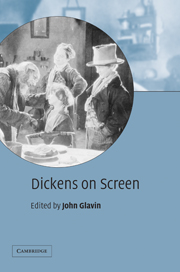Book contents
- Frontmatter
- Contents
- List of illustrations
- Notes on the contributors
- Acknowledgments
- Introduction
- Part I
- Part II
- Part III
- Part IV
- 11 Cinematic Dickens and uncinematic words
- 12 Dickens, Eisenstein, film
- 13 Orson Welles and Charles Dickens 1938–1941
- 14 David Copperfield (1935) and the US curriculum
- 15 Dickens, Selznick, and Southpark
- 16 Tiny Tim on screen: a disability studies perspective
- Part V
- Index
- References
11 - Cinematic Dickens and uncinematic words
Published online by Cambridge University Press: 22 September 2009
- Frontmatter
- Contents
- List of illustrations
- Notes on the contributors
- Acknowledgments
- Introduction
- Part I
- Part II
- Part III
- Part IV
- 11 Cinematic Dickens and uncinematic words
- 12 Dickens, Eisenstein, film
- 13 Orson Welles and Charles Dickens 1938–1941
- 14 David Copperfield (1935) and the US curriculum
- 15 Dickens, Selznick, and Southpark
- 16 Tiny Tim on screen: a disability studies perspective
- Part V
- Index
- References
Summary
The field of novel/film studies is troubled with a central critical paradox. On the one hand, scholars declare film's integral formal, narrative, and historical connections to the novel, especially the Victorian novel. Sergei Eisenstein decrees the Dickensian novel “cinematic” (1949: 195). Christian Metz argues that film took over the social function of the Victorian novel (1977: 110). On the other hand, scholars argue that film and the novel are inherently opposed as “words” and “images.” The same Eisenstein, and most film aestheticians following him, insist that any type of verbal narration in film is “uncinematic” (Stromgren and Norden 1984: 173). Nowhere is this paradox more marked than in the claim that Dickens is “cinematic” but that words are not. What, after all, is “Dickens” apart from words? This chapter argues against both claims: that Dickens is cinematic, and that words are not.
The opening of David Lean's 1946 film of Great Expectations exemplifies this paradoxical theoretical claim. The film begins with a shot of the novel, Great Expectations, opened to chapter 1. John Mills, who plays the adult Pip, reads the opening paragraph in a clipped, dry voice-over: “My father's family name being Pirrip, and my christian name Philip, my infant tongue could make of both names nothing longer or more explicit than Pip. So, I called myself Pip, and came to be called Pip.”
- Type
- Chapter
- Information
- Dickens on Screen , pp. 113 - 121Publisher: Cambridge University PressPrint publication year: 2003
References
- 2
- Cited by



